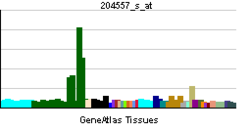- DZIP1
-
DAZ interacting protein 1 Identifiers Symbols DZIP1; DZIP; DZIPt1; KIAA0996; RP11-23E3.3 External IDs OMIM: 608671 MGI: 1914311 HomoloGene: 45708 GeneCards: DZIP1 Gene Gene Ontology Molecular function • nucleic acid binding
• protein binding
• zinc ion binding
• metal ion bindingCellular component • intracellular
• nucleus
• cytoplasm
• protein complexBiological process • multicellular organismal development
• germ cell development
• spermatogenesis
• cell differentiationSources: Amigo / QuickGO RNA expression pattern 

More reference expression data Orthologs Species Human Mouse Entrez 22873 66573 Ensembl ENSG00000134874 ENSMUSG00000042156 UniProt Q86YF9 n/a RefSeq (mRNA) NM_014934.3 NM_025943.2 RefSeq (protein) NP_055749.1 NP_080219.2 Location (UCSC) Chr 13:
96.23 – 96.3 MbChr 14:
119.27 – 119.32 MbPubMed search [1] [2] Zinc finger protein DZIP1 is a protein that in humans is encoded by the DZIP1 gene.[1]
References
Further reading
- Kimura K, Wakamatsu A, Suzuki Y, et al. (2006). "Diversification of transcriptional modulation: large-scale identification and characterization of putative alternative promoters of human genes.". Genome Res. 16 (1): 55–65. doi:10.1101/gr.4039406. PMC 1356129. PMID 16344560. http://www.pubmedcentral.nih.gov/articlerender.fcgi?tool=pmcentrez&artid=1356129.
- Gerhard DS, Wagner L, Feingold EA, et al. (2004). "The status, quality, and expansion of the NIH full-length cDNA project: the Mammalian Gene Collection (MGC).". Genome Res. 14 (10B): 2121–7. doi:10.1101/gr.2596504. PMC 528928. PMID 15489334. http://www.pubmedcentral.nih.gov/articlerender.fcgi?tool=pmcentrez&artid=528928.
- Moore FL, Jaruzelska J, Dorfman DM, Reijo-Pera RA (2004). "Identification of a novel gene, DZIP (DAZ-interacting protein), that encodes a protein that interacts with DAZ (deleted in azoospermia) and is expressed in embryonic stem cells and germ cells.". Genomics 83 (5): 834–43. doi:10.1016/j.ygeno.2003.11.005. PMID 15081113.
- Ota T, Suzuki Y, Nishikawa T, et al. (2004). "Complete sequencing and characterization of 21,243 full-length human cDNAs.". Nat. Genet. 36 (1): 40–5. doi:10.1038/ng1285. PMID 14702039.
- Moore FL, Jaruzelska J, Fox MS, et al. (2003). "Human Pumilio-2 is expressed in embryonic stem cells and germ cells and interacts with DAZ (Deleted in AZoospermia) and DAZ-like proteins.". Proc. Natl. Acad. Sci. U.S.A. 100 (2): 538–43. doi:10.1073/pnas.0234478100. PMC 141031. PMID 12511597. http://www.pubmedcentral.nih.gov/articlerender.fcgi?tool=pmcentrez&artid=141031.
- Strausberg RL, Feingold EA, Grouse LH, et al. (2003). "Generation and initial analysis of more than 15,000 full-length human and mouse cDNA sequences.". Proc. Natl. Acad. Sci. U.S.A. 99 (26): 16899–903. doi:10.1073/pnas.242603899. PMC 139241. PMID 12477932. http://www.pubmedcentral.nih.gov/articlerender.fcgi?tool=pmcentrez&artid=139241.
- Christian SL, McDonough J, Liu Cy CY, et al. (2002). "An evaluation of the assembly of an approximately 15-Mb region on human chromosome 13q32-q33 linked to bipolar disorder and schizophrenia.". Genomics 79 (5): 635–56. doi:10.1006/geno.2002.6765. PMID 11991713.
- Nagase T, Ishikawa K, Suyama M, et al. (1999). "Prediction of the coding sequences of unidentified human genes. XIII. The complete sequences of 100 new cDNA clones from brain which code for large proteins in vitro.". DNA Res. 6 (1): 63–70. doi:10.1093/dnares/6.1.63. PMID 10231032.
Categories:- Human proteins
- Chromosome 13 gene stubs
- Biology of bipolar disorder
Wikimedia Foundation. 2010.
